
|
|
| www.wildfirenews.com | Updated (PST): Tue, 14 Jan 2003 11:15:15 |
MOUNT RAINIER FIRE CHOPPERS SENT OVERSEASJANUARY 14 -- FORT LEWIS, WA: Most of the Army Reserve helicopters used for rescue missions on Mount Rainier and to drop water on wildfires have been called up for active duty, leaving a potential gap in firefighting resources for the state of Washington.
Steve Winslow, chief high-altitude ranger at Mount Rainier National Park, said there are few alternatives to the large, twin-rotor Chinooks for high-altitude rescue missions. Other available helicopters have a ceiling of about 9,000 feet, and fixed-wing aircraft that are used to search from the air cannot land on the 14,411-foot peak. Chinooks can operate to about 19,400 feet. "There's just not that many resources out there that can do what the Chinook can do for us," said Winslow. If the deployment lasts past spring, wildfire suppression efforts this summer could be affected. The Chinooks are used for bucket work on fires around the state. Capt. Grant Haugen, commander of the unit, said some rescue capacity would remain at Fort Lewis. Two pilots, three or four flight engineers and other civilian employees are staying at company headquarters, along with at least one helicopter and all search and rescue gear except for a couple hoists. "It will be much more limited, and it will probably be reserved for the most serious conditions," Haugen said. TEXAS WILL TEST-DRIVE HEALTHY FORESTS INITIATIVEJANUARY 13 -- NEW WAVERLY, TEXAS: The Sam Houston National Forest will be one of 10 forests nationwide that will be testing the Bush administration proposal to streamline the process for fuels reduction on national forests. Beginning next week, forest managers will study the areas proposed for thinning. About 7,500 acres of dense pine forest 60 miles north of Houston will be thinned and burned this year as part of the Healthy Forests Initiative. The Tyler Morning Telegraph reported that other test projects are being conducted in Idaho, Nevada, California, Oregon, Utah, Michigan and Washington. The initiative, first announced last August, expands the number of projects exempt from environmental oversight -- and makes it tougher for advocacy groups to file appeals. "It will speed up the process," said Brandt Mannchen, forestry chairman for the Houston Sierra Club. "It will make it harder for the public to figure out what is going on." The policy, if adopted, could be applied across 190 million acres of public land at high risk of fires and debilitating insect infestations. "These common-sense reforms would reduce the overlapping studies required by current law that result in undue delay," said James Houser, president of the Texas Forestry Association. On the Sam Houston, management efforts will be focused on a 15,555-acre area known as Four Notch that has a long history of controversy. Problems began in the 1980s when a beetle outbreak destroyed 2,600 acres. When the Forest Service attempted to clear and replant the area, environmentalists chained themselves to trees and equipment in protest. "The process has really slowed us down," said Tim Bigler, district ranger. "We need to take action whenever biology is dictating something needs to be done." The USFS lists quarterly projects for the 675,658-acre National Forests and Grasslands in Texas at www.southernregion.fs.fed.us/texas TEENAGERS ON TRIAL FOR ARSONJANUARY 13 -- COLORADO SPRINGS, CO: Two teenage boys go to trial today, charged with setting Colorado's first major wildfire of 2002, according to KOAA-TV. In April more than 2000 acres burned in the Snaking Fire near Bailey, Colorado. Two 15-year-old boys will go to trial before a Park County judge on fourth-degree arson charges. A third teenager is awaiting his trial date; though the Park County district attorney had originally asked that all three boys be tried as adults, they will be tried as juveniles. AUSTRALIAN FIREFIGHTERS BUSY IN NEW SOUTH WALESJANUARY 10 -- SYDNEY, NSW: Fire crews are working hard to contain 72 fires across NSW ahead of expected drier conditions on Sunday, with half of the fires still outside containment lines. A news.com.au report said recent rainfall was not enough to extinguish fires in the Wollondilly area southwest of Sydney, but it did make for difficulty in backburning. John Winter with the Rural Fire Service said firefighters had another 5 miles of containment line to build. In the Brindabella Ranges of southern NSW, about 50 firefighters were working on backburns supported by 11 aircraft, including the Air-Crane and K-Max helicopters. "There's such dry conditions down there they're finding it hard to put out the fires while crews are actually standing there," said Winter. "We are taking advantage of the much milder conditions with the weather expected to remain calm, though we expect it to dry out over the weekend, Sunday afternoon, Monday, and expect fire activity to spark up again within 48 hours." HAYMAN FIRE SHOWED COLORADO RESIDENTS THE VALUE OF THINNINGJANUARY 10 -- WOODLAND PARK, CO: The U.S. Forest Service is planning to thin 20,000 acres of the forest north and west of Woodland Park by late next summer or early fall. And most of the residents near the site last year's Hayman Fire couldn't agree more. Planning began two years ago, according to a report by the Colorado Springs Gazette, long before the Hayman Fire in June destroyed 133 homes in a four-county area. The Forest Service released the draft environmental impact statement this week. But before the project can get under way, public meetings must be held and the environmental impact statement must be finalized. Community meetings are scheduled for January 22 - 23 in Woodland Park and Divide. "This place is dry, and it's time we did some thinning," said resident Laura Hansen. "We need it. We've been worried about wildfires out here for several years." And Rayne Reese, owner of nearby Pike's Peak Paradise, a bed and breakfast, said she couldn't agree more. "They say you can't really prevent some disasters, like if you live in San Francisco and there's an earthquake," Reese said. "But wildfires are a whole different animal, and there are precautions we can take." The Forest Service has rehab and recovery info for the Hayman Fire online, and the Pike - San Isabel is online at www.fs.fed.us/r2/psicc AIRTANKER THAT CRASHED HAD A PREVIOUS LIFE AS A SPY PLANEJANUARY 06 -- RENO, NV: The National Transportation Safety Board investigator who has examined the crash of a C-130A airtanker last summer has found that the reason some of the records on the former Air Force plane are missing is that it was used to fly spy missions for the CIA. An Associated Press report says the discovery has renewed criticism of the Forest Service for putting the surplus military plane to work fighting fires. "Apparently this ... airplane at one point in time was set up along with a few others for electronic surveillance -- as in CIA activity -- somewhere in the world," said George Petterson, an NTSB air safety investigator. "Those kind of airplanes basically don't exist records-wise. That could be the reason why we don't have a good history on this airplane." Investigators can't determine whether the aircraft flew as little as 3,000 hours or as many as 20,000 hours with the wing assembly that broke off in June, killing all three crew members in a crash in California. It was built by Lockheed in 1956 and released from Davis-Monthan AFB in 1988. Petterson said the Air Force modified many of its C-130As with new wing parts in the 1980s, but he can't tell whether T-130 was one of those modified. "The modifications were being done because they were having problems with the airplanes' wings cracking," he said. The Air Force indicated the records of the wing modifications have been destroyed, according to Petterson. He added that the company that performed the modifications, Aero Corp. in Lake City, Florida, kept the records for many years, but they since have been destroyed. Critics of the Forest Service firefighting fleet have alleged that planes on contract to the agency were being used in covert operations after they had left the military and were in the possession of private contractors. The aviation director at Forest Service headquarters in Washington said the lack of documentation is a major concern. "We know some aircraft that were part of the aircraft exchange act ended up flying overseas," said Tony Kern. "I don't know for what agency. If he says CIA, he might be right. We also are aware there are gaps in the records of these aircraft, not just for that period of time, but records that never were transferred across from the military." The aircraft exchanges were halted under the Clinton administration, but most of the planes remain in the hands of the private contractors. "This is a major issue we are going to address with whatever aircraft we go with next," said Kern. SHOULD IT COST YOU MORE TO BUILD IN A STUPID PLACE?JANUARY 04 -- DENVER, CO: Insurance companies are paying out more for wildfires, but they still don't see the connection between defensible space in the wildland-urban interface and the cost of coverage. In fact, insurance experts say homeowners in the interface share the same general risk factors as homeowners in the suburbs: the distance between a home and a fire station, and access to water for firefighting.
"For good or bad, insurance is based on the numbers," says Carole Walker of the Rocky Mountain Insurance Information Association. "It's going to be based on loss experience. I don't think anybody would want their insurance to be based on speculation about risk." But others disagree. They say insurance companies should re-examine their policies, because the risk of wildfire is so clear, the number of people moving into the interface is growing rapidly, and the patterns of wildfires are becoming familiar. Some say that insurance companies are imposing higher premiums on their broader clientele to subsidize the mountain lifestyle choice. William Baker, a University of Wyoming geography professor and forest fire scholar, summarizes the argument this way: "Most Americans have a sense of fair play. If you want to build in a (fire-prone red zone), you should have to pay more." In Colorado this summer, insurance companies paid out a record $70 million for just the four biggest fires in the state: Hayman, Missionary Ridge, Iron Mountain, and Coal Seam. The Hayman Fire alone accounted for $39 million. The most expensive wildfire for insurers -- $1.7 billion -- was the 1991 Oakland Hills fire in California. Availability of insurance became an issue in Colorado this year as people scrambled to find coverage at the height of the wildfire season. A temporary pullback in coverage delayed home sales because buyers couldn't get insurance while fires were burning in areas nearby. The cessation of coverage prompted the Colorado Division of Insurance to accuse the state's insurers of overreacting. But insurance companies cite the far greater payouts from hail damage in Colorado. Maria Taylor with State Farm noted the company's $24.5 million payout for wildfire damage in 2002, compared to $37.3 million for hail damage. "In 1990, we had one hailstorm that cost us $140 million," she said. IF YOU DON'T FIX IT, WE WILLJANUARY 03 -- SANTA FE, NM: County commissioners representing 17 counties have petitioned the Secretary of Agriculture to deal with the threat of catastrophic fires in New Mexico. KOBTV reported this morning that more than 100 state legislators also have signed the petition, drafted by Albuquerque lawyer Clifford Nichols. The petition was sent to Agriculture Secretary Ann Veneman, but Nichols says he hasn't heard back from her. The petition asks that the federal government either reduce the fuel loads in national forests in the state that are at risk of catastrophic fire or transfer limited jurisdiction to the state to remedy forest conditions. Otherwise, the petition says the federal government must assume liability for any damages caused by foreseeable catastrophic fires. A TRAGIC YEAR REMEMBEREDJANUARY 03 -- BAKER, OR: The deaths of five La Grande-based firefighters who died June 21 when their van rolled on the way to a fire in Colorado was voted the No. 1 news story of 2002 by the La Grande Observer news staff. The accident made national news as Colorado fought one of the worst fire seasons in its history. The fatal van accident came just after the news that the fire the Grayback Forestry crew was dispatched to had been set by a Forest Service employee. Retha Shirley, 19, and Daniel Rama, 28, from Baker City, Oregon; Jake Martindale, 20, from Boise, Idaho; Bartholomew Bailey, 20, of Corvallis, Oregon.; and Zachary Zigich, 18, of Twin Falls, Idaho, were killed. Seven others in the van were injured. The Grand Junction Sentinel staff voted the van crash the No. 9 story of 2002 and reported that the van was part of a convoy of eight vehicles and 63 firefighters en route to the 137,000-acre Hayman Fire. State Patrol troopers said that the driver of the van, Megan Helm, was distracted when the van veered off the left side of Interstate 70 and into the median; Helm then overcorrected and went off the right side of the highway. The van rolled four times and ejected several of the firefighters. Four died at the scene, and a fifth died later. Despite opposition from some of the families of the firefighters who were killed, District Attorney Mac Myers charged Helm with six misdemeanor counts of careless driving causing death and serious injury in the accident. Many people from Helm's home state as well as some from Garfield County expressed anger and dismay that she was charged. She entered pleas of not guilty to the charges in July. A hearing was set for December 4 but was then continued until January 22. The charges are class one traffic offenses, punishable by 10 days to one year in jail and/or a fine of $100 to $1,000. Helm remains free on bond. A TOAST TO GORDON KNIGHTJANUARY 01 -- BOULDER, CO: When Justin Dombrowski hoists a Twisted Pine beer, he thinks of his pal Gordon Knight. Brewed in Boulder, Gordon Knight's Twisted Pine beer won accolades and awards among professional brewers from coast to coast. A decorated Vietnam veteran, Knight was "basically retired," said Dombrowski, but still he rode his bicycle to work as a firefighting helicopter pilot; he died in July when the engine of his 32-year-old helicopter melted above the Big Elk Fire. The Grand Junction Sentinel reported today that Knight was one of nine wildland firefighters who died during the 2002 season; the paper's news staff voted the wildfire season the No. 2 story of the year. Seasons like this one drain the enthusiasm from firefighters passionate about their work, said a weary Dombrowski last week. He spent most of the year working as a fire information officer. "There's a drive and a passion among firefighters to push themselves," Dombrowski said. "When you start having fatalities, it takes that fun and drive out of people. I used to walk around with more of a smile on my face at fire camp." He said the toll the year took on the spirits of firefighters was tremendous. "When you start hearing of wings falling off airtankers ... it's hard to keep going with the same motivation," said Dombrowski. Around the country, 97 firefighters lost their lives this year. Of those, 21 were wildland firefighters, and of those, nine died in Colorado alone. Five Oregon firefighters -- Bartholomew Bailey, Jacob Martindale, Retha May Shirley, Daniel Rama, and Zachary Zigich -- died in an accident June 21 while traveling to the Hayman Fire. Tanker pilots Milt Stollak and Rick Schwartz died when T-123 fell apart on the Big Elk Fire, and Alan Wyatt died while mopping up after the Missionary Ridge Fire. And Gordon Knight, too, died during the Big Elk Fire. "Not too many people could do the kinds of things he could do with a helicopter and a bucket," said Marc Mullenix, head of the Rocky Mountain Interagency Helitack crew, where Knight worked for two years. "Crews working below Gordon knew he was the one flying." The Denver Post reported that Knight probably saved the lives of some groundpounders on the Big Elk Fire. Mullenix said Knight was dousing hot spots on the fire, and he steered the falling helicopter away from firefighters working below him. "He avoided certain disaster. That was the kind of person he was," Mullenix said. At his memorial service, friends shared "Gordon stories," recalling Knight as a selfless man who gave and gave, never asking for anything in return. Several talked about his award-winning skills as a beer brewer, praising his expertise and chuckling over his lack of confidence. Despite winning three gold medals at Great American Beer Festivals for three different brews, Knight typically pitched his beers with the preface, "You're probably not going to like it." When he did sell beer, he usually told buyers to pay him later rather than when the beer was delivered. "You're probably not going to be able to sell it," he'd say. While making a water drop on the Big Elk Fire near Estes Park, Colorado, Knight suddenly radioed that he was going down. His helicopter crash was witnessed in a remote area. Knight was a former EMS helicopter pilot, and flew for both Des Moines Life Flight and Denver's Flight For Life. His wife, Susan, is a former flight nurse, and she worked for both programs as well. Other news items on Gordon Knight are available from the Rocky Mountain News, realbeer.com, the Payson Hotshots tribute page, the Fort Collins Coloradoan, thedenverchannel.com, abcnews.com, beertravelers.com, coloradofirechiefs.org, insidedenver.com, Wildfire magazine, and 1stresponder.com. COLORADO FOREST SERVICE REIMBURSES DURANGO FIRE FOR MISSIONARY RIDGE EXPENSESJANUARY 01 -- DURANGO, CO: Reimbursement from the Colorado State Forest Service (CSFS) to the Durango Fire & Rescue Authority for its work during the Missionary Ridge Fire will help the local agency purchase new ambulances. The Durango Fire & Rescue Authority received $446,589 from CSFS for fighting the Missionary Ridge Fire, which burned 70,085 acres during the summer of 2002. According to the Durango Herald, it was the largest reimbursement awarded by the state to local firefighting agencies. Local agencies in Colorado received more than $9.5 million in reimbursements for the season; during 2001 about $1.3 million was paid out for firefighting efforts. Half of the money received by the Durango Fire & Rescue Authority will cover overtime for staff and volunteer firefighters who responded to the Missionary Ridge Fire, according to Dave Abercrombie, public information officer for the agency. The remainder will pay for two new ambulances. "We like to put it into capital rather than just pouring it into our operational budget," said Abercrombie. "We came across the extra money, and said, 'Where do we have a need for a capital expenditure?'" Because the Rescue Authority has taken over the ambulance service, Abercrombie said it seemed prudent to use the money to purchase new equipment. Durango Fire & Rescue topped the list for reimbursement with its payment of $446,589. Rocky Mountain Interagency Helitack, a consortium of Boulder County agencies, received $440,279 for use of a helicopter on the Big Elk and other fires. That helicopter crashed at the Big Elk Fire, killing pilot Gordon Knight, but the agency leased a new helicopter to finish the season. The CSFS also offers wildland fire training through its Colorado Wildfire Academy and Great Plains Wildfire College. For more information, contact Wendy Fischer at the Colorado Wildfire Academy, P.O. Box 1777, Alamosa, Colorado 81101 or email [email protected] or phone (719)589-3138. The CSFS site also includes information on their Wildfire and Mitigation conference. CHEDISKI FIRE-STARTER ARRESTEDDECEMBER 11 -- TOLLESON, AZ: KOLD-TV in Tucson reported yesterday that Valinda Jo Elliot, the woman who started the Chediski Fire, has been arrested. Elliot was arrested early Sunday in Tolleson on charges of driving under the influence and other charges. Neither Elliot or her attorney could be reached for comment. According to the Arizona Republic, Elliott, 32, of south Phoenix, was arrested for DUI and other traffic violations after failing field-sobriety tests and registering a blood-alcohol level of 0.177 percent, more than the 0.15 level considered extreme DUI under Arizona law. Earlier this summer, Elliot said she was lost for two nights on the Fort Apache Reservation when she set a signal fire on June 20 to attract the attention of a news helicopter overhead. The Chediski merged with the Rodeo Fire, creating the largest wildfire in Arizona history. The Rodeo-Chediski Fire destroyed 467 homes and burned 469,000 acres, but Elliot was never charged with a crime for her actions. The Arizona Republic reported that on July 18 the U.S. attorney for Arizona told an angry crowd at Mogollon High School that Elliott would not be prosecuted because she did not act with criminal intent when she set her "signal fire." He said there was no chance a jury would convict her of arson, and that investigators had spent a month interviewing witnesses, checking cellphone logs, and following other leads to confirm every detail of her account. It took $43.1 million control the Rodeo-Chediski, not counting the cost of mop-up and rehab operations. AFTER THE FIRES: AUSTRALIANS BLAME GOVERNMENT FOR NOT COMPLETING FUELS REDUCTIONDECEMBER 10 -- SYDNEY, NSW: The New South Wales government is facing questions and criticism over its hazard reduction policy today as the state's bushfire crisis eases and the clean-up begins. The discussion escalated yesterday, and news.com.au reported that firefighters focused on backburning and mopping up, with temperatures dropping for the first time in days. Opposition spokesman on special affairs of state, Barry O'Farrell, had claimed last weekend that only 1 percent of national parks had been hazard reduced in the past year -- when experts had recommended seven percent. He released Freedom of Information documents showing that State Forests had conducted about 111,000 acres of hazard-reduction burns this year, but had also apparently counted more than 296,000 acres in cattle grazing. O'Farrell wants the government to justify a claim that more than 1.2 million acres were hazard reduced. Governor-General Peter Hollingworth visited the Rural Fire Service headquarters at Rosehill yesterday, commending firefighters for their efforts. He said bushfires were a fact of life in Australia, especially during times of drought, and that people needed to understand the risks. Firefighters are taking advantage of cooler weather conditions to try to bring the bushfires under control. More than 60 fires continued to burn across NSW and about 4,000 firefighters were still out on the fires. The Australian reported that temperatures fell yesterday to about 63º and are expected to reach a high of 77º today.
Yesterday another U.S. helitanker arrived in Sydney; "Elvis" is the third Erickson Air-Crane brought in from Oregon. The S-64 helitankers have been fighting fire on annual contract for the Australian Department of Natural Resources and Environment since 1997. The helitankers usually operate from a base at Essendon Airport near Melbourne in the State of Victoria. Yesterday the state's bushfire chief slammed homeowners who built houses too close to bushfire danger areas, often using the wrong materials. NSW Rural Fire Service commissioner Phil Koperberg also said rural building codes were too lax. He rejected criticism that firefighters didn't do enough to save some of the 50 homes lost in recent fires. Koperberg said some houses in rural areas were built too close to bush, were inaccessible, badly designed, and made of the wrong materials. "I am some sometimes surprised at the amount of risk that people attract to themselves by being so close to very steep terrain which is heavily timbered," he told ABC radio. He said there was no question that building codes, design, and material requirements for rural construction had been too lax. SUPPRESSION COST TIMES THREE?DECEMBER 08 -- DURANGO, CO: Might the actual cost of the Missionary Ridge Fire be $120 million, three times the current estimate? Which costs more -- fuels reduction or firefighting? Denny Lynch, a Colorado State University professor, has spent years studying the costs of fires and comparing forest restoration costs with fire costs. The Durango Herald reported that Lynch's conclusions suggest that firefighting is always more expensive than restoration.
These costs, often ignored in the accounting that reports the price of fire, bumped the tab for the Bobcat Gulch Fire to $9.9 million -- over $940 per acre. "We're almost at a magnitude of three of what it really cost versus the suppression cost," Lynch said. His calculations applied to the Missionary Ridge Fire would swell the $40.8 million suppression cost to more than $100 million. Restoration efforts cost money. But it's rarely close to $900 per acre. "You can take this money out in the parking lot and burn it" for all the long-term benefit that comes from fires, Lynch said. Restoration work or thinning work is an investment, he adds, but it's not as expensive nor as dangerous as firefighting. "We could fly over poor communities and throw out bales of money and not put their lives at risk." U.S. AIRTANKER FLEET LOSES A QUARTER OF ITS PLANESDECEMBER 07 -- BOISE, IDAHO: Federal agencies grounded C-130A and PB4-Y airtankers yesterday after an aviation panel reported that the government's aerial firefighting program is unsafe and rife with problems. The Forest Service also grounded its 19 Baron lead planes and four Sherpa smokejumper planes. The Sacramento Bee reported that the loss of one-quarter of the fleet could make it harder for firefighters to attack Western wildfires next summer. But officials said they had little choice. "What we have found is a system in need of repair," said Forest Service Chief Dale Bosworth and BLM Director Kathleen Clarke in a joint statement. "What began as an innovative program in the 1950s to use recently retired military and civilian surplus aircraft ... now needs improvement." The Associated Press reported that the C-130A would have been pulled from the firelines years ago if the Forest Service had listened to warnings from the agency's own experts, the Agriculture Department's inspector general, a private whistleblower, and prosecutors in the Justice Department's fraud unit. The agency was told repeatedly that the 46-year-old aircraft that went down in California in June never should have been released from the Air Force "boneyard" at Davis-Monthan Air Force Base in 1988 and given virtually free to a firefighting contractor. "This is the Achilles heel of the nation's firefighting effort," said Jim Lyons, who was an assistant U.S. agriculture secretary from 1993 to 2000. Calling the Forest Service's longtime use of planes retired from the military a baffling "beg, borrow and steal operation," he said he had proposed purchasing an up-to-date firefighting fleet, but the plan went nowhere. "For an organization like the Forest Service -- with the size of their firefighting operation and expense to the taxpayers -- it was always remarkable to me that this was the way they secured aircraft." The Arizona Republic reported that with 25 percent of the total fleet grounded, officials expect significantly less help from the air in 2003. "Tactically, there's going to have to be some hard decisions that are going to have to be made," said Roy Hall, operations chief on one of the Southwest's two national incident management teams. "This decision was driven by a major issue, though -- firefighter safety." "This will force some changes in the way we do things," said Clay Templin, an Arizona BLM firefighter. "It's one more constraint we're going to have to deal with." Federal officials say they will work to backfill the loss of the C-130A's and PB4-Y's with other types of aircraft. But Jerry Williams, the Forest Service's Fire & Aviation director, said it could take three to five years to get the kind of aircraft they need. After the crashes of two airtankers this summer, Bosworth and Clark appointed a commission -- the "blue ribbon panel" of experts -- to examine federal aerial firefighting. The panel held hearings and collected input and examined the program, and yesterday released their 60-page report. The Rocky Mountain News reported that the firefighting fleet operates in a system that is seriously broken, one that has a "deplorable" safety record, no testing or inspection program, and contracts that ignore reality. Officials said the remaining 35 planes in the fleet would not fly until a rigorous new inspection program is developed. The panel's report noted the deaths of 136 pilots in airtanker crashes since 1958, what they called an "abysmal" safety record. If firefighters on the ground had experienced the same death rate, according to their report, more than 200 a year would have died. The report says the Forest Service lead planes -- Beechcraft Baron BE-58P's -- don't have the power to maintain altitude in the high-elevation wildfire environment. It said federal agencies offer no incentive to contractors to ensure that airtankers are safe -- and that contract-related safety disincentives exist. The panel concluded that federal fire agencies have adopted a widespread, short-term pursuit of cost-efficiency. "A narrow cost-focus is evident in Forest Service and BLM contracts that do not reward value, performance, or safety," they said. "A lack of clear understanding about the long-term or life-cycle costs is evident in day-to-day fire management decisions, safety-sensitive positions that remain vacant for extended periods, and asset-related decisions to save money." "The 2002 National Airtanker Service Contract requires adherence to federal regulations but does not require operators to conduct safe operations," says the report. "Nothing in the contract requires contractors to operate their aircraft in accordance with maintenance and inspection schedules tailored to the known conditions of an aerial firefighting environment. The panel saw no evidence that contracting offices either knew about or had attempted to address known structural issues to ensure that contractor aircraft could be operated safely. The panel found nothing in the current airtanker contract that provided incentives for contractors to operate safely." The panel's report slammed the fire agencies's aviation programs, questioning the effectiveness and efficiency of a system that requires six or more separate national interagency coordinating bodies to agree on an action to be taken. "The culture, organizational structure, and management of federal wildland fire management agencies are ill-suited to conduct safe and effective aviation operations in the current environment," said the report. Information on the blue ribbon panel is online at www.nifc.gov/blueribbon and the 60-page report is online in PDF format. NEED A GOOD HOLIDAY GIFT? |

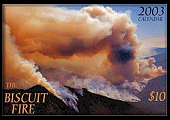





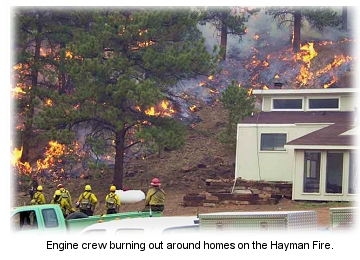 The fact that homes are surrounded by flammable forest doesn't figure in, according to a report by the
The fact that homes are surrounded by flammable forest doesn't figure in, according to a report by the 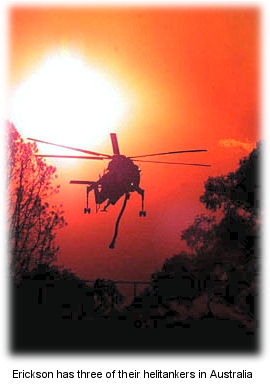 Farther north in the state, though, temperatures were expected to remain in the 90s with very little chance of rain.
Farther north in the state, though, temperatures were expected to remain in the 90s with very little chance of rain.
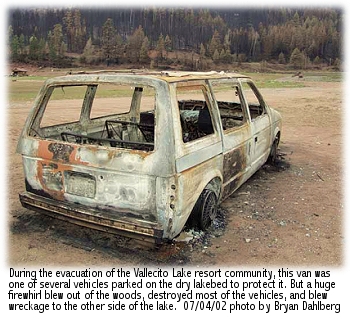 A case in point: the Bobcat Gulch Fire of June 2000. The 10,599-acre fire started with an illegal campfire. Suppression costs ran $3.8 million, or $362.33 per acre. But Lynch tracked all the costs related to the fire: the loss of insured property and associated tax revenues, law enforcement, Red Cross administration, and rehabilitation. There was also the cost to private property owners of a fire-related fish kill and pond cleanup, control of noxious weeds that followed the fire, road repairs, a flood-warning system, water treatment, wildlife monitoring, replacing electric and phone utilities, business losses, and county costs.
A case in point: the Bobcat Gulch Fire of June 2000. The 10,599-acre fire started with an illegal campfire. Suppression costs ran $3.8 million, or $362.33 per acre. But Lynch tracked all the costs related to the fire: the loss of insured property and associated tax revenues, law enforcement, Red Cross administration, and rehabilitation. There was also the cost to private property owners of a fire-related fish kill and pond cleanup, control of noxious weeds that followed the fire, road repairs, a flood-warning system, water treatment, wildlife monitoring, replacing electric and phone utilities, business losses, and county costs.

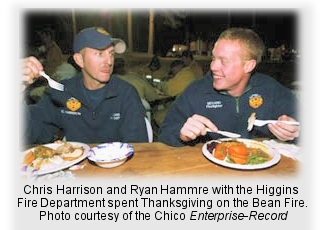
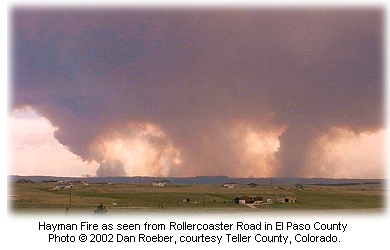 That was one of several findings released in a 200-plus page report last week, according to the
That was one of several findings released in a 200-plus page report last week, according to the